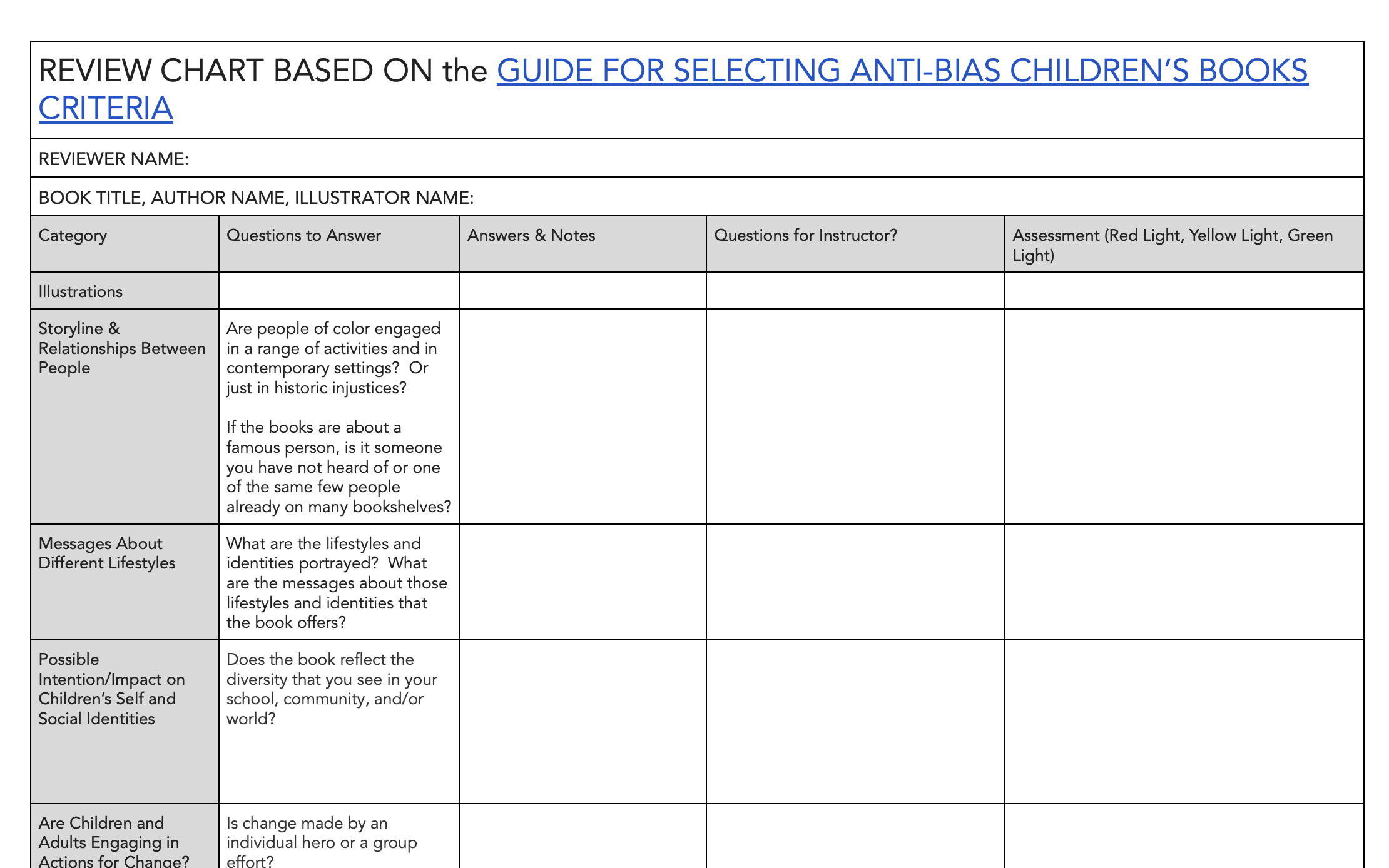By Zapoura Newton-Calvert
As a professor at Portland State University teaching a Capstone course focused on social justice education, I have been using the resources at Social Justice Books for many years. When I became a fellow with Teaching for Change, I was delighted to expand my work and to engage my students in the practice of writing critical book reviews. Of course, a book review isn’t just a thumbs up or thumbs down for a book, especially when it comes to this organization’s work. It’s a process of participation in anti-oppression learning that involves research, critical analysis, and anti-bias thinking.
To scaffold the critical book review process for my students, I translated the categories and questions in Louise Derman-Sparks Guide for Selecting Anti-Bias Children’s Books into an easy-to-use chart for students to fill out section by section. I then created a template for drafting the critical review and implemented peer and instructor feedback and revision as final steps in the process.
Introducing the Review Chart as a Teaching & Learning Resource
The Guide for Selecting Anti-Bias Children’s Books Review Chart correlates directly to the Derman-Sparks model but breaks up each category (and its associated questions) into smaller pieces. The chart also creates space for notes and answers to the critical questions, questions for the instructor/facilitator, and a rating (recommended, recommended with a caveat, not recommended) for each category to help with overall assessment of the book.
At the end of the chart, there is space for an overall rating and any research materials the student has used to create the review. Research on the author, illustrator, and book topic are encouraged.
TEACHING TIP: Do one or two of your own reviews before asking your students to go through this process. You’ll learn a lot about the analysis tool and what it’s like to participate in this practice. You might be surprised how much you learn about yourself, the areas where you’re strong in this practice, and the areas where you have room to grow.
Additional Scaffolding
Using this review chart does require some additional scaffolding for optimal learning.
Becoming Familiar with Red, Yellow, and Green Reviews
Become familiar with the Social Justice Books Project booklists and red (not recommended), yellow (recommended with a caveat), and green light (recommended) designations. My students read the following books and accompanying reviews:
- Yellow Dog Blues (a green light book)
- Abuela’s Weave (a yellow light book)
- The World Needs More Purple People (a red light book)
Then they wrote a reflection that included making a list of the qualities/characteristics that make each book a green, yellow, or red light book. As a wrap up to this activity, we discussed what makes a book recommended, recommended with a caveat, or not recommended and what techniques the author’s used in their reviews (research, direct quotes, analysis, description, etc.).
Practice Using the Rubric Together
Have students do a collaborative sample book review of a common book first. I use Yuyi Morales’ Dreamers. Together, we go through each category of the rubric and fill out the sections, asking questions and having discussion as we go.
Drafting, Feedback, and Revision: Using Examples & Templates
Throughout the drafting, feedback, and revision process, students are able to look at myriad examples of other reviews and an annotated example of a review I wrote. This gives them practice thinking about basic structure for their writing. Together, we look at an annotated review that comments on what is happening in each section of the review paragraph by paragraph (Annotated Book Review Draft). I then offer a Template for Book Review Draft so that they can get started without just a blank page, which can create anxiety.
TEACHING TIP: I ask my students to choose a book from the SJB lists that intersect with at least one of their own identities as a first book to review. This allows students to read a book that provides a mirror and also gives them a place to write from with confidence and with some authority. For a second book, I ask my students to choose a book that does not intersect with any of their identities. After going through both processes, we hold a conversation about the similarities and differences between the two experiences on emotional, critical, and technical levels.
What We’ve Learned So Far…
So, my students and I have learned a lot from the process. Not only do we hone our critical thinking skills, our anti-oppression lenses, and our writing ability, but we also have learned a lot about ourselves and each other and have created stronger relationships through the sharing of the stories we’ve read and our own stories, too. In a final assignment that I give at the end of the term, I ask students to simply name three things they learned from the review writing process. One student wrote:
- A yellow review opens us up for dialogue and discussion — which are needed when considering making social change.
- It’s important and liberatory to consider, challenge, and adjust internalized beliefs, especially when they are detrimental or oppressive to other communities.
- I really enjoy writing book reviews!
As you can see, there are layers to this process. And these layers represent joy and justice, self-reflection and an understanding of community, and skills that can be strengthened and used in all kinds of social justice work.
Zapoura Newton-Calvert serves as a fellow with Teaching for Change. She is a professor, emergent strategist, curriculum writer, and co-founder of Reading Is Resistance.

Leave a Reply